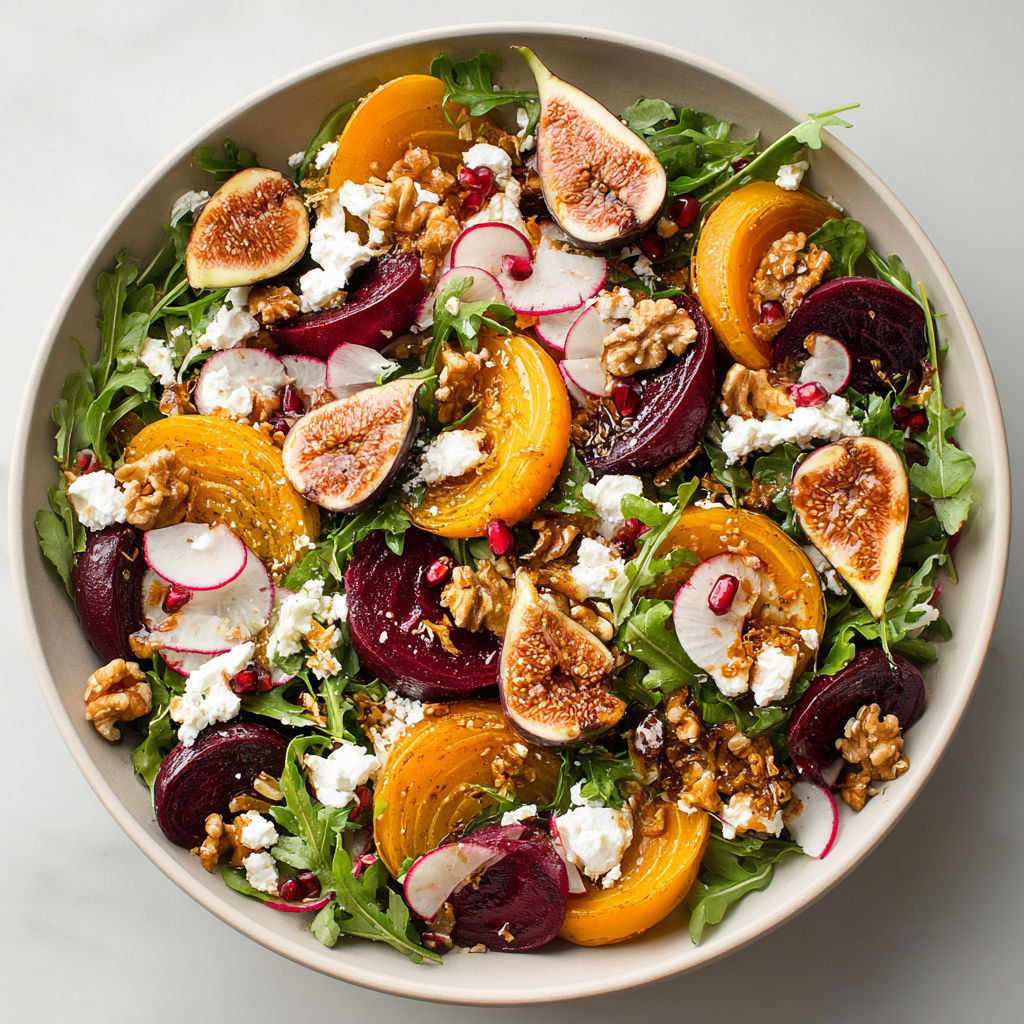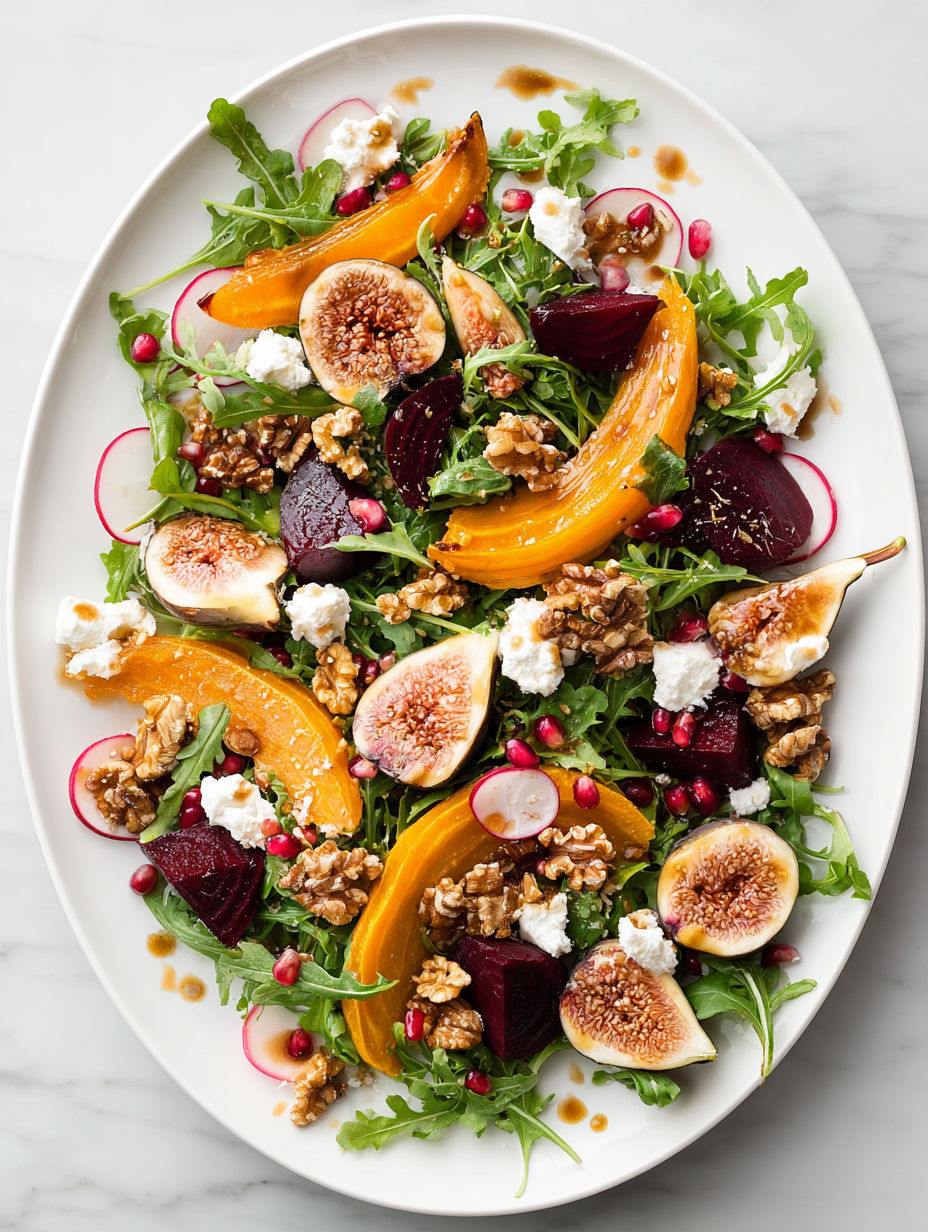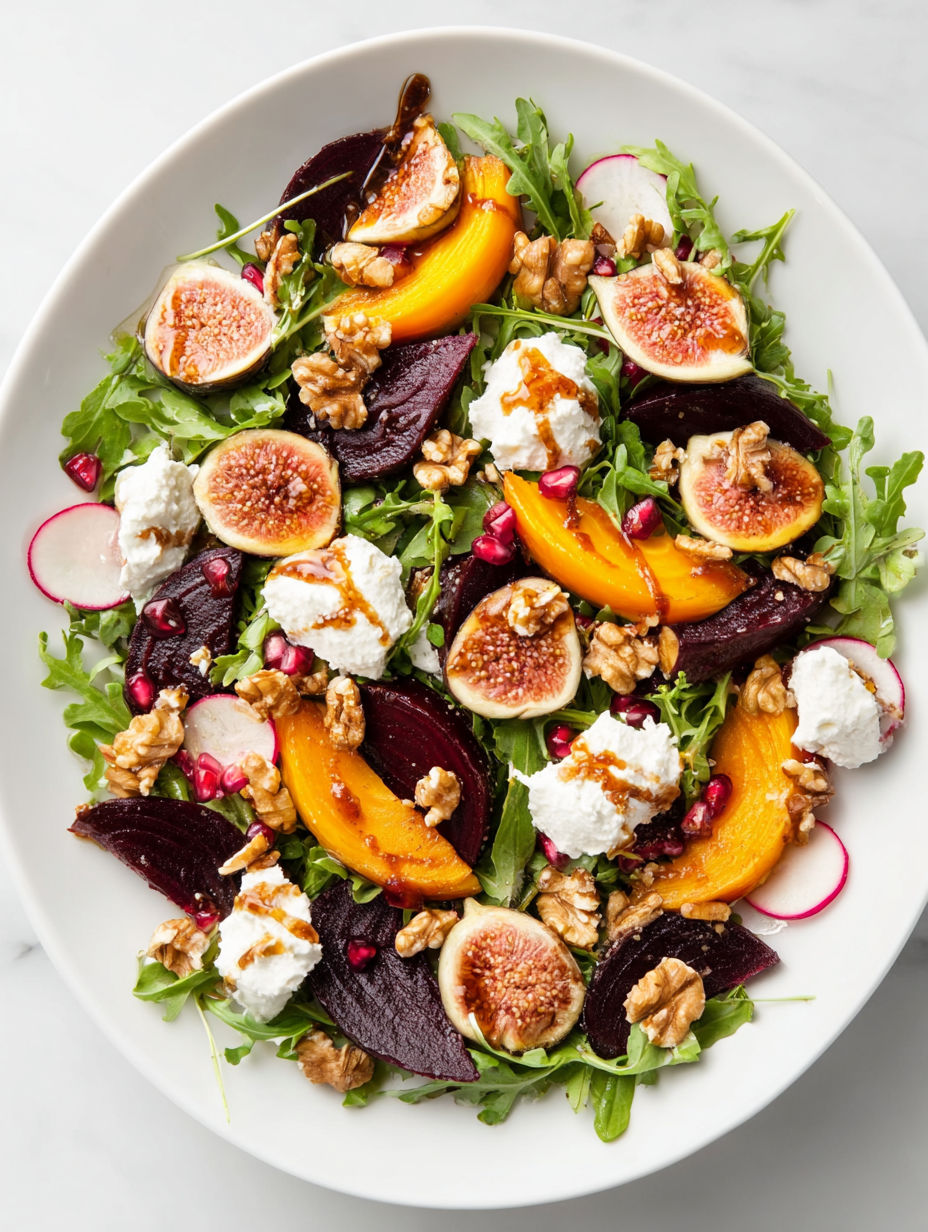 Bookmark
Bookmark
This fall beet and fig salad with goat cheese is a vibrant, makeahead side perfect for Thanksgiving, Friendsgiving, or a cozy weeknight dinner. It brings together the earthiness of beets, the mellow sweetness of fresh figs, and the creamy tang of goat cheese, all tossed with peppery arugula and finished with crunchy toasted walnuts and bright pomegranate seeds. The maplebalsamic dressing adds a glossy, sweet tart finish that ties everything together beautifully.
I first made this salad during an autumn dinner party in Lyon and everyone raved about the combination of textures and flavors. It has since become my go to seasonal salad when the markets burst with fresh beets and figs.
Ingredients
- Two medium fresh red beets: trimmed and scrubbed to bring deep earthiness and vibrant color Choose firm beets with smooth skins to ensure freshness
- Two golden beets: trimmed and scrubbed to add mild sweetness and a contrasting hue Keep these separate from red beets to prevent color bleeding
- Four fresh figs: halved, offering natural sweetness and a soft texture Look for figs that are plump but not overly mushy
- Three cups baby arugula: adding a peppery bite and leafy freshness Select fresh, crisp leaves without blemishes
- Three radishes: thinly sliced for crunch and mild spice Choose small, firm radishes with bright color
- Half a cup crumbled goat cheese: contributing creamy tartness Opt for soft, fresh goat cheese with a smooth texture
- Half a cup toasted walnuts: providing warm crunch and nuttiness Use unblemished walnuts and toast them lightly to enhance flavor
- Half a cup pomegranate arils: delivering bursts of juicy sweetness Use fresh arils to keep the salad vibrant and colorful
- Three tablespoons extravirgin olive oil: for the dressing which adds richness and fruity notes Choose olive oil with a balanced flavor
- One tablespoon balsamic vinegar: bringing bright acidity and sweetness Look for a good quality aged balsamic for deeper complexity
- One tablespoon pure maple syrup: lending natural sweetness and a hint of woodsy flavor Opt for real maple syrup rather than syrup blends
- One teaspoon Dijon mustard: to emulsify the dressing and add mild spice Use a smooth, good quality mustard for best results
- Half a teaspoon salt: to season and bring out flavors Use fine sea salt or fleur de sel for subtle texture
- Quarter teaspoon freshly ground black pepper: adding mild heat and aroma Grind fresh for best intensity
Instructions
- Roast the beets:
- Heat the oven to 200°C and prepare two separate foil packets, one for red beets, one for golden beets to keep their vibrant colors from mingling. Rub each beet lightly with olive oil and a pinch of salt before wrapping. Place on a baking sheet and roast for 45 to 60 minutes, until a skewer slides through easily. Allow them to cool slightly for safe handling.
- Cool, peel, and cut the beets:
- Once warm but not hot, rub the skin off with a paper towel to avoid sogginess from water. Remove the root ends and cut the beets into bite sized wedges or oneinch chunks. Keep the red and golden beets separated in bowls to prevent color transfer, which can affect plating aesthetics.
- Toast the walnuts:
- Place walnuts on a small baking sheet and toast at 175°C for about 6 to 8 minutes or use a dry skillet on medium heat shaking the nuts frequently for 3 to 4 minutes until they become fragrant and lightly browned. Immediately transfer them to a cool plate to stop residual cooking. For a flavor boost, toss warm walnuts with a small pinch of salt and a drop of maple syrup while cooling.
- Make the maple balsamic dressing:
- Whisk together extravirgin olive oil, balsamic vinegar, pure maple syrup, Dijon mustard, salt, and freshly ground black pepper until the mixture is glossy and emulsified. Taste and adjust the seasoning by adding more salt for depth or extra vinegar for brightness depending on your preference.
- Prepare the salad components:
- Halve the figs, slice the radishes thinly, and pat the arugula very dry to ensure the dressing clings well. Remove pomegranate seeds from the fruit and blot them on paper towels to minimize juice bleeding on the salad.
- Dress the greens:
- Toss the arugula lightly with one to two tablespoons of dressing in a large bowl, just enough to coat without wilting the greens. Spread the dressed leaves evenly onto a serving platter or divide them onto individual plates.
- Finish and serve:
- Toss the golden beets with a teaspoon of dressing and arrange them over the greens. In a separate small bowl, mix the red beets with a teaspoon of dressing and plate carefully so the colors do not blend. Nestle in the fig halves, scatter sliced radishes, toasted walnuts, crumbled goat cheese, and pomegranate arils evenly across the salad. Drizzle with a delicate finishing splash of dressing to make the salad glisten. Add a crack of fresh black pepper and a few flakes of salt if you like, then serve promptly for best flavor and texture contrast.

Mon ingrédient préféré est sans doute la grenade. Chaque arille est une petite explosion de fraîcheur acidulée qui complète parfaitement la douceur ronde des figues et la terre chaude des betteraves. Cette salade me rappelle chaque année les longues soirées d’automne partagées autour de la table avec mes proches, où les saveurs se mêlent et les sourires s’élargissent.
Conservation
Pour conserver la salade, il est préférable de garder séparément les betteraves, les figues, les noix, la roquette et la vinaigrette dans des contenants hermétiques. Cela aide à préserver la texture et la fraîcheur. Assemblez la salade juste avant de servir. Les betteraves se conservent très bien au réfrigérateur jusqu’à quatre jours, les noix grillées maintiennent leur croquant si elles sont rangées dans un récipient hermétique à température ambiante.
Substitutions d’ingrédients
Si vous n’avez pas de chèvre frais, un fromage de noix de cajou au goût légèrement acidulé peut être une alternative intéressante, en particulier pour une option sans lactose ou végétalienne. Pour remplacer les figues fraîches, vous pouvez utiliser des raisins rouges rôtis, qui apportent une douceur similaire et une couleur proche. Enfin, les noix peuvent aussi être remplacées par des graines de courge toastées, ajoutant une croquant différent et une note légèrement salée.
Suggestions de service
Cette salade délicate se marie à merveille avec un plat principal légèrement épicé comme un poulet grillé aux herbes ou encore un saumon poché. Pour un repas plus léger, servez-la en entrée accompagnée d’un bon pain de campagne. Garnissez la salade d’un filet supplémentaire de vinaigrette juste avant de servir pour raviver les saveurs si elle a reposé quelques heures.

Assemblez la salade juste avant de servir pour préserver la texture et la fraîcheur.
Common Recipe Questions
- → Comment cuire les betteraves pour conserver leur couleur ?
Rôtissez les betteraves rouges et dorées séparément en les enveloppant dans du papier aluminium pour éviter que les couleurs ne se mélangent et ne se tachent.
- → Quelle alternative utiliser au fromage de chèvre ?
Vous pouvez remplacer le fromage de chèvre par un fromage à base de noix de cajou pour conserver une texture crémeuse et une saveur délicate.
- → Comment préparer la vinaigrette érable-balsamique ?
Fouettez ensemble l’huile d’olive, le vinaigre balsamique, le sirop d’érable, la moutarde de Dijon, le sel et le poivre jusqu’à obtention d’un mélange brillant et homogène.
- → Peut-on remplacer les figues fraîches ?
Les raisins rouges rôtis apportent une douceur similaire et un ton visuel proche des figues, apportant une note fruitée et juteuse.
- → Comment conserver le croquant dans cette salade ?
Ajoutez des noix toastées et des graines de grenade pour un contraste de textures qui sublime chaque bouchée.
